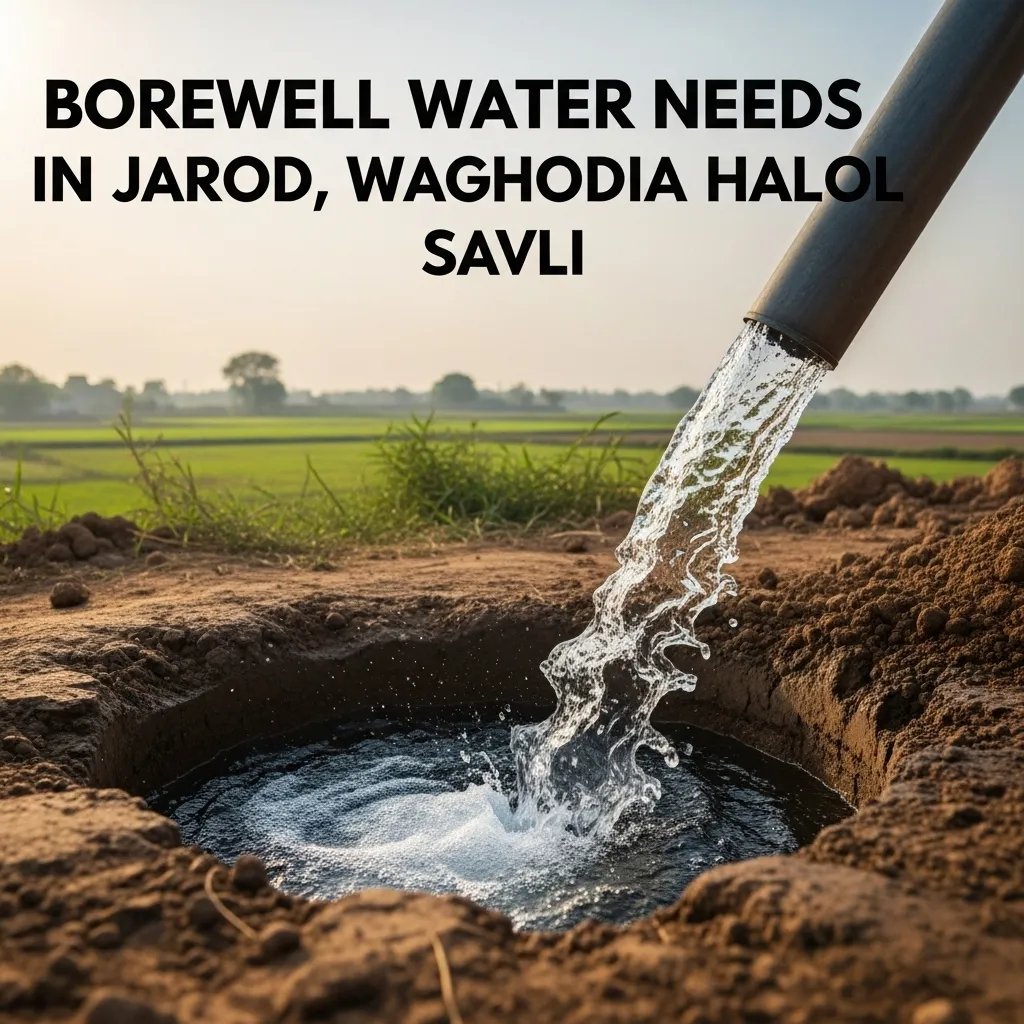Groundwater remains the most dependable source of water in central Gujarat. In areas around Vadodara—Jarod, Waghodia, Halol, and Savli— The demand for borewell water has been rising sharply due to agricultural expansion, industrial development, and population growth. According to Central Ground Water Authority (CGWA) reports, Vadodara district has experienced a steady decline in the water table by 0.2–0.5 meters annually in industrial belts, making regulated borewell drilling and recharge practices essential.
At Vishal Borewell Drilling Service, we combine four decades of field experience with modern groundwater survey techniques to ensure sustainable borewell solutions for these regions.
Borewell Water Needs in Jarod
Jarod is primarily an agriculture-driven region where borewells are critical for irrigation. Farmers rely on groundwater for cultivating crops like cotton, maize, and vegetables.
- Estimated agricultural water demand: ~18–20 million liters/day during peak cropping seasons.
- Groundwater level trend: Fluctuates between 40–60 feet post-monsoon and dips to 90–110 feet in summer.
- Key challenges: Falling water table due to over-extraction during dry months.
Here, periodic borewell cleaning and recharge through rainwater harvesting can significantly improve sustainability.
Borewell Water Needs in Waghodia
Waghodia is a rapidly expanding industrial and residential hub. The Gujarat Industrial Development Corporation (GIDC) estate in Waghodia has attracted pharmaceuticals, chemicals, and engineering industries, all of which depend on groundwater.
- Industrial water demand: ~25–30 million liters/day (process water, cooling, and cleaning).
- Domestic demand: Rising with residential colonies, around 5–7 million liters/day.
- Groundwater level trend: Declining at 0.3 meters/year, requiring close monitoring.
Piezometers with Digital Water Level Recorders (DWLRs) are critical in Waghodia to monitor aquifer stress and comply with CGWA norms.
Borewell Water Needs in Halol
Halol has emerged as a manufacturing hub with multinational companies in automobile, electrical, and heavy engineering sectors. Its industrial dependency on groundwater is among the highest in Vadodara district.
- Industrial demand: ~40–45 million liters/day, with cooling and cleaning forming a major share.
- Agricultural demand: Still significant in surrounding villages at 12–15 million liters/day.
- Groundwater level trend: Seasonal fluctuation from 80–100 feet post-monsoon to 140+ feet in summer.
This high dependency means industries must adopt rainwater harvesting and recharge wells to offset extraction, as mandated by CGWA.
Borewell Water Needs in Savli
Savli, home to one of Gujarat’s largest GIDC estates, is both an industrial powerhouse and a growing residential zone. Industries like power equipment, engineering, and chemicals dominate here.
- Industrial demand: ~35–40 million liters/day.
- Residential demand: Increasing rapidly with new townships, ~8–10 million liters/day.
- Groundwater level trend: Annual decline of 0.4 meters, indicating over-exploitation risk.
Here, flow meters, piezometers, and structured rainwater harvesting systems are not just compliance tools but survival strategies.
Comparative Water Demand Analysis
Region | Major Water Use | Industrial Demand (MLD) | Agricultural Demand (MLD) | Domestic Demand (MLD) | Avg. Water Level (Post-Monsoon) | Summer Depth Trend | Annual Decline |
Jarod | Agriculture + Domestic | 2–3 | 18–20 | 3–4 | 40–60 ft | 90–110 ft | 0.2 m |
Waghodia | Industrial + Domestic | 25–30 | 4–6 | 5–7 | 70–85 ft | 110–130 ft | 0.3 m |
Halol | Industrial + Agriculture | 40–45 | 12–15 | 6–8 | 80–100 ft | 140+ ft | 0.4 m |
Savli | Industrial + Domestic | 35–40 | 6–8 | 8–10 | 75–90 ft | 120–140 ft | 0.4 m |
(MLD = Million Liters per Day)
Technical Challenges and Solutions
- Challenge 1: Falling Water Tables
- Solution: Install piezometers with DWLR to monitor levels.
- Challenge 2: Seasonal Shortages
- Solution: Construct rainwater harvesting structures to recharge aquifers post-monsoon.
- Challenge 3: Over-reliance on Borewells
- Solution: Diversify with surface water sources and reduce wastage through flow meters.
- Challenge 4: Non-Compliance Risks
- Solution: Ensure strict adherence to CGWA guidelines to avoid fines and borewell sealing.
How Vishal Borewell Ensures Reliable Water Solutions
At Vishal Borewell, we focus on scientific drilling and compliance-based water management. Our services include:
- Borewell drilling and maintenance with geological surveys.
- Piezometer observation well installation with DWLR and telemetry.
- Rainwater harvesting design and execution.
- Groundwater mapping and hydrogeological studies.
- Submersible motor pump installation.
- Flow meter setup for accurate extraction records.
- CGWA consultancy and NOC documentation support.
Conclusion
The regions of Jarod, Waghodia, Halol, and Savli highlight the growing challenge of balancing water demand between industries, agriculture, and households. With groundwater levels declining and extraction needs rising, scientific borewell drilling, piezometer monitoring, and rainwater harvesting are no longer optional—they are urgent necessities.
At Vishal Borewell Drilling Service, we are committed to delivering sustainable, compliant, and technically sound solutions that secure water for today and safeguard it for tomorrow.
📞 Contact us at 8469877021 or visit 🌐 vishalborewell.com for expert borewell and groundwater solutions in Vadodara and nearby regions.
